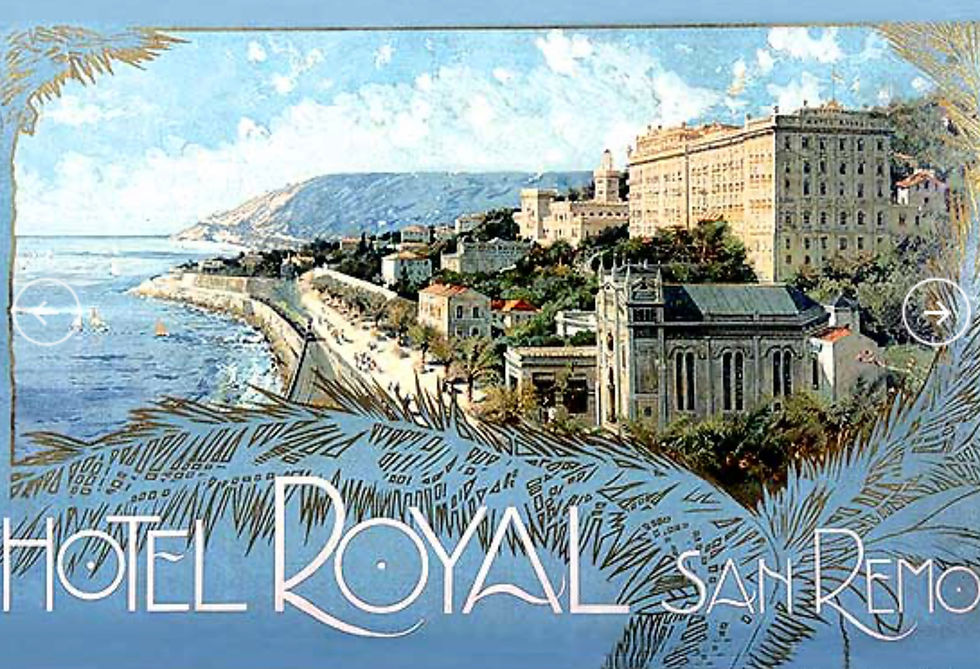When planning the first week of this summer's sailing, I came across the name of San Remo. A name I had not heard for a while. It brought me back to my childhood when San Remo was as popular as Monaco

San Remo Poster from the 1920s
Memories of spectacular motor bike races flashed back, of prominent movie stars, elegant hotels and palm shaded promenades. I remembered the notion that San Remo was the play ground of the rich and famous during Italy’s Dolce Vita. The Swiss Illustrated Magazine, the country's only gossip weekly which my brother and I eagerly read on our monthly visit to the hairdresser, always had photos from San Remo. Grey-haired Mr. Wirz, our hairdresser, had a ginormous pile of these magazines..

The last Formula One Race was held in 1951
San Remo was not alone in its glamour. The Riviera di Ponente with its long sand and pebble beaches was as famous as the French Côte d’Azur. But its allure faded as more coasts with beautiful beaches came within the reach of tourists. The eastern half of Liguria is quite the contrary though. Cinque Terre with its tiny villages perched on sharp cliffs or nestled in narrow valleys attracts more and more visitors.

The Riviera di Ponente stretches from Ventimiglia to Genoa, the Riviera di Levante with Cinque Terre from Genoa to Tuscany. San Remo is on the Riviera den Fiori (west)
The Riviera di Ponente was always a hard a place to live. With mountains rising straight out of the sea, there was never enough space for agriculture. People living here had to make their peace with the sea and the mountains and make money from fishing, trading, olive oil and wine making to buy the other foods they needed. It is not a coincidence that three of Italy’s eight long-distance trading towns were on the Ligurian coast: Genoa, Savona and Noli. The other five are widely spread over Italy: Pisa, Gaeta, Amalfi, Ancona & Venice.

Savona is missing on this map
With the collapse of the Byzantine Empire and the fall of Constantinople in 1453, long-distance trading ended abruptly. The coastal ship yards lost their customers. Only Genoa who was fighting Spain’s war in the Mediterranean against the Ottoman Fleet, continued to order galleys. Not surprisingly, Genoa was able to extend its influence over most of Liguria. The Genovese fortress of Santa Tecla, overlooking San Remo’s port, dates from this time (1753). People had to live from fishing and making olive oil (the best in Italy people say) Large coastal settlements shrank to small villages. It was a stagnating economy.

The Genovese Fortress Santa Tecla was built in 1753 to control the Port of San Remo
All this changed with the invention of steam engines in England in the first half of the 19th century. Towards the middle of this century, the technology was sufficiently advanced to challenge sails.

Passenger Ticket from 1856 for an Atlantic Crossing - Steam replaced Sailing
Rail roads were built all over Europe and in North America. The world was shrinking. Journeys that took months before could now be done in weeks and days. The large English upper class took notice. Travelling to Europe had always been part of their curriculum. Now it could be done more efficiently. Reaching Liguria from London by coach would take about two months’ time. Taking a sailboat around Spain was a bit faster but still took a minimum of one month. Neither was practical. But with steamers it could be done in less than a week and by train (the famous French Wagon Lits) in three days.

The Growth of French Railways over only 20 years
English tourists were a game changer for western Liguria. With its mountains merging into the Alps, the valleys and rivers, fed by melt water, were considerably larger than in Eastern Liguria. The resulting sand and pebble deposits formed the long beaches the Riviera di Ponente is known for. Modern settlements could be built on the river deltas. In San Remo, these efforts started slowly in 1830 and accelerated once the railway reached the village in 1872 . Between 1850 and 1880 the town’s large boulevards were built, the luxurious hotels followed. With Cannes on the Côte d/Azur, San Remo became the first sea side resorts. And it would stay this way for a long time, attracting nobles, wealthy and prominent people from around the world.

The first World War was disruptive but with Italy fighting on France’s and England’s side, the four years were not devastating. The town retained its splendor and built on it during the rearing twenties. The motorization brought a Grand Prix to town, bicycle races (Milano – San Remo) were held. Some of the Versailles follow-on conferences took place in San Remo

The second World War had a deeper impact as it cut of tourism for almost ten years. Efforts to revitalize tourism included a music and film festival which helped for a while.

Advertisement for San Remo's Music Festival in 1964
But the arrival of the Boeing 737 and the DC-9 made far cheaper destinations in Spain, Greece & Turkey accessible. The closest airport to San Remo is actually not in Italy but in Nice, 45 min by car. Could not get hold of statistics but tourist arrivals started to stagnate in the 1980. The glamour was replaced by mass tourism and cheap beach holidays. The town’s former glory is still visible though but most old luxury hotels are now closed, the Formula One race is no more and the once famous Music festival is now an online event.

San Remo's famous sand beach right in the middle - behind it the old tourist town built in the 19th century, towards the right is the original old village
Hozzászólások